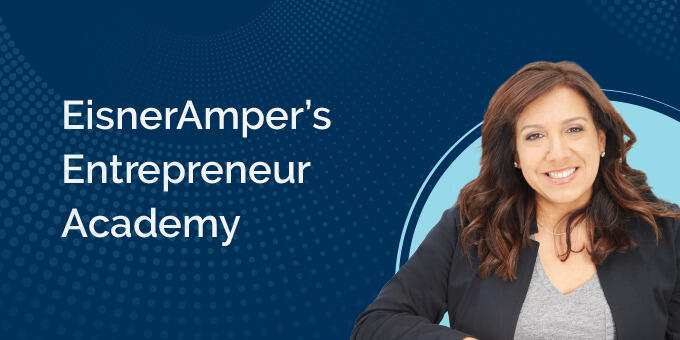Entrepreneur Academy
- Published
- Apr 22, 2022
- Topics
- Share
Becoming a public company through an acquisition by a SPAC is an alternative to the traditional initial public offering (IPO). In this video, you’ll learn some key considerations that a technology or life sciences company should keep in mind before being acquired by a SPAC.
Transcript
Nina Kelleher: Hi I’m Nina Kelleher, Eisner’s National Leader for Special Purpose Acquisition Companies otherwise known as SPAC Services and a Director in EisnerAmper Digital focusing on risk advisory services and business process optimization.
Becoming a public company through an acquisition by a SPAC has increased in popularity over the last two years as an alternative to the traditional initial public offering (IPO) route. With over 300 sponsors that have filed with the SEC for an IPO and more than another 500 SPACs searching for a target or waiting to complete a transaction, it’s no wonder I receive a lot of inquiries from tech and life sciences companies about how they can best be positioned to be a acquired by a SPAC.
Oftentimes, when I’m called in for advice, I start by asking if their company is ready to operate as a publicly traded company. If the answer is no, then there is still some work to be done before the company is ready to go public via a SPAC.
What I find there is often a misconception in the marketplace by target companies wanting to tap capital markets through a SPAC in that the target company doesn’t have to be as mature or go through the same regulatory requirements than it would the traditional IPO route or direct listing. This just isn’t the case. The target company would still need to gain approval from regulators. Once the de-SPAC process is completed, the company will be publicly traded and the route to get there, whether a traditional IPO, SPAC or direct listing, the regulations on a publicly traded company are the same.
It is true that the timeline to go public via a SPAC is typically shorter with than the traditional IPO route, so with that, it is critical that the target company can show the sponsor they are essentially operating like a public company.
Let’s go over some key considerations that a tech or life Science company that wants to be acquired by a SPAC should keep in mind.
Accounting and Tax Considerations:
- Are my tax and accounting departments adequately prepared for the transition to a public company?
- Do relevant personnel maintain the competence to apply and adhere to more complex accounting standards?
- Do my current policies and procedures account for highly scrutinized areas such as revenue recognition, lease accounting, and equity-based compensation?
Financial Statement Preparation:
Assessing the financial statement preparation procedures of a target company is one piece of the financial health puzzle.
The items I encourage companies to think about are:
- Are my company’s financial statements prepared in compliance with U.S. Securities and Exchange Commission (SEC) reporting requirements?
- Do my company’s financial statements include the required level of disclosures, footnotes, management discussion and analysis (MD&A), etc.?
- Is my company prepared to develop pro forma financial information in accordance with the future SPAC transaction?
Compliance with Required Filings and Registrations:
Once public, there is a whole new set of acronyms to learn: AICPA, PCAOB, and SEC, Converting audit standards and considering various independence rules can be a challenge.
Some questions to consider include:
- Have we converted the audit of our financial statements from under the AICPA standards to under PCAOB standards?
- Is our auditor a PCAOB-registered public accounting firm that is independent under the SEC and PCAOB independence rules?
- Is my company prepared to complete the necessary registration statements?
Internal Controls and Sarbanes-Oxley (SOX) Compliance:
Companies will need to assess their internal control environment and the ability to comply with SOX requirements. I encourage companies to try answering these questions, among others, regarding internal controls to better evaluate their readiness.
Some questions to consider include:
- Are policies and procedures for key areas of my business related to financial reporting formally documented and reviewed periodically?
- Has management established clear lines of reporting and an effective tone at the top?
- Are periodic assessments performed to identify risks relevant to my organization’s achievement of objectives?
Lastly, Cybersecurity and Information Technology
There’s so much here for companies to consider, but at the core, having a sound IT infrastructure that has the ability to scale with the expected growth as a result of the newly injected capital from going public is paramount along with a robust cybersecurity posture.
These are just a few of the key areas that tech and life Sciences companies should focus when assessing their readiness to go public via a SPAC.
To learn more, visit our SPACs Knowledge Center or start a conversation with us.
Entrepreneur Resource Hub
EisnerAmper’s Entrepreneur Academy “EA2” offers early-stage startups continuous learning opportunities—from fundraising to mitigating risk to growing their businesses.
What's on Your Mind?
Start a conversation with Nina
Receive the latest business insights, analysis, and perspectives from EisnerAmper professionals.



